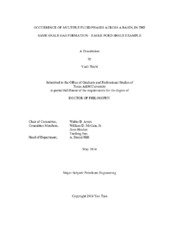| dc.description.abstract | Shale gas and oil are playing a significant role in US energy independence by reversing declining production trends. Successful exploration and development of the Eagle Ford Shale Play requires reservoir characterization, recognition of fluid regions, and the application of optimal operational practices in all regions.
Using stratigraphic and petrophysical analyses, we evaluated key parameters, of reservoir depth and thickness, fluid composition, reservoir pressure, total organic carbon (TOC), and number of limestone and organic-rich marl interbeds of the Lower Eagle Ford Shale. Spatial statistics were used to identify key reservoir parameters affecting Eagle Ford production. We built reservoir models of various fluid regions and history matched production data. Well deliverability was modeled to optimize oil production rate by designing appropriate operational parameters.
From NW to SE, Eagle Ford fluids evolve from oil, to gas condensate and, finally, to dry gas, reflecting greater depth and thermal maturity. From outcrop, the Eagle Ford Shale dips southeastward; depth exceeds 13,000 ft at the Sligo Shelf Margin. We divided Eagle Ford Shale into three layers. The Lower Eagle Ford is present throughout the study area; it is more than 275 ft thick in the Maverick Basin depocenter and thins to less than 50 ft on the northeast. In the Lower Eagle Ford Shale, a strike-elongate trend of high TOC, high average gamma ray values, and low bulk density extends from Maverick Co. northeastward through Guadalupe Co. Both limestone and organic-rich marl beds increase in number from fewer than 2 near outcrop to more than 20 at the shelf margins. Average thicknesses of Lower Eagle Ford limestone and organic-rich marl beds are low (< 5 ft.) in the La Salle – DeWitt trend, coincident with the most productive gas and oil wells. Eagle Ford Shale was divided into 5 production regions in South Texas that coincide with the regional, strike-elongate trends of geologic parameters, which suggests that these parameters significantly impact Eagle Ford Shale production.
Eagle Ford Shale production (barrels of oil equivalent, BOE) increases consistently with depth, increases with Lower Eagle Ford thickness (up to 180-ft thickness), and increases with TOC (up to 7%). P values analyses suggest high certainty of the relationship between the production and five reservoir parameters tested in regression models.
Multiple good history matches of a gas condensate well suggest significant uncertainties in reservoir parameters. Oil production rate is not sensitive to oil relative permeability for the gas condensate well model. We were unable to match the production history for the volatile oil wells, possibly because gas of lift. Reservoir modeling suggests low bottomhole flowing pressure was the key to optimize cumulative oil production.
Concepts and models developed in this study may assist operators in making critical Eagle Ford Shale development decisions; they may be transferable to other shale plays. | en |


